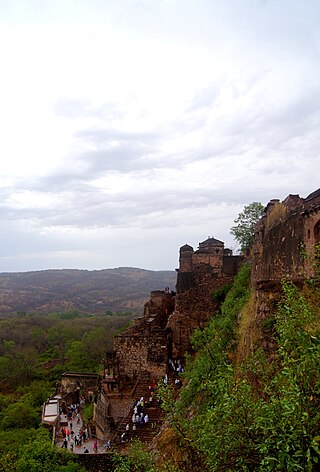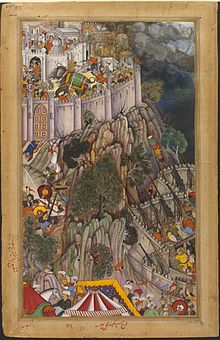
Jauhar, sometimes spelled Jowhar or Juhar, was a Hindu Rajput practice of mass self-immolation by females, both adults and children, in the Indian subcontinent to avoid capture, enslavement and rape by Turko-Persian Islamic invaders when facing certain defeat during a war. Some reports of jauhar mention women committing self-immolation along with their children. This practice was historically observed in the northwest regions of India, with most famous jauhars in recorded history occurring during wars between Hindu Rajput kingdoms in Rajasthan and the opposing Turko-Persian Muslim armies. Jauhar was only performed during war, usually when there was no chance of victory. The term jauhar often connotes jauhar-immolation. Jauhar involved Hindu Rajput women committing suicide with their children and valuables in a massive fire, in order to avoid capture and abuse in the face of inescapable military defeat. At the same time or shortly thereafter, the men would ritualistically march to the battlefield expecting certain death, which in the regional tradition is called saka. This practice was intended to show that those committing it valued their honor more highly than their lives.

Chittorgarh is a major city in the state of Rajasthan in western India. It lies on the Berach River, a tributary of the Banas, and is the administrative headquarters of Chittorgarh District. It was a major stronghold of the Rajput State of Medapata. The city of Chittorgarh is located on the banks of river Gambhiri and Berach.

Rao Maldeo Rathore was a king of the Rathore dynasty, who ruled the kingdom of Marwar in present day state of Rajasthan. Maldeo ascended the throne in 1531 CE, inheriting a small ancestral principality of Rathore's but after a long period of military actions against his neighbours, Maldeo swept significant territories which included parts of present day Rajasthan, Haryana, Uttar Pradesh, Gujarat and Sindh. He refused to ally with either the Sur Empire or the Mughal Empire.

The Chittorgarh, also known as Chittod Fort, is one of the largest living forts in India. It is a UNESCO World Heritage Site. The fort was the capital of Mewar and is located in the present-day city of Chittorgarh. It sprawls over a hill 180 m (590.6 ft) in height spread over an area of 280 ha above the plains of the valley drained by the Berach River. The fort covers 65 historic structures, which include four palaces, 19 large temples, 20 large water bodies, 4 memorials and a few victory towers.

Ranthambore Fort lies within the Ranthambore National Park, near the city of Sawai Madhopur in Sawai Madhopur district of Rajasthan, India. the park being the former hunting grounds of the Maharajahs of Jaipur until the time of India's Independence. It is a formidable fort having been a focal point of the historical developments of Rajasthan. The fort is believed to be constructed by numerous kings from Several Dynasties including The Yadavas, Chahamana Rajputs, Hada Rajputs, Mewar Rajput Kings and then the Delhi Sultanate captured it for a brief time. The fort provides a panoramic view of the surrounding Ranthambore National Park and is now a popular tourist attraction.

The history of human settlement in the western Indian state of Rajasthan dates back to about 100,000 years ago. Around 5000 to 2000 BCE many regions of Rajasthan belonged as the site of the Indus Valley Civilization. Kalibangan is the main Indus site of Rajasthan, here fire altars have been discovered, similar to those found at Lothal.

The Kingdom of Mewar, also called Medapata, was an independent kingdom that existed in the Rajputana region of the Indian Subcontinent and later became a dominant state in medieval India. The kingdom was initially founded and ruled by the Guhila dynasty followed by the Sisodiya Dynasty. The earliest kingdom was centered around the south-central part of Rajasthan, state of India. It was bordered by the Aravali Range to the northwest, Ajmer to the north, Gujarat, Vagad and Malwa regions to the south and the Hadoti region to the east.

Abu'l-Fath Jalal-ud-din Muhammad Akbar, popularly known as Akbar the Great, and also as Akbar I, was the third Mughal emperor, who reigned from 1556 to 1605. Akbar succeeded his father, Humayun, under a regent, Bairam Khan, who helped the young emperor expand and consolidate Mughal domains in the Indian subcontinent. He was considered one of the greatest emperors of India in Indian history.

Maharao Chatra Sal or Shatru Sal (1632–1658) was one of the most prominent and illustrious ruler of Hada-Chauhan dynasty of the Kingdom of Bundi. He built the temple of Keshavrao at Kishorai-Patan and Chatra Mahal in the upper storey of Taragarh Fort,Bundi.

Bundi State, founded by Hada Rao Devda, was a princely state in British India. The former state was located in modern-day Rajasthan. It was ruled by Hada Chauhan Rajputs.

The siege of Chittorgarh was the military expedition of the Mughal Empire under Akbar against the Mewar kingdom that commenced in 1567 during which the Mughals successfully captured the fort of Chittorgarh after a hard-pressed siege which lasted for several months.
The Mughal–Rajput wars were a series of battles between the Rajput Confederacy and the Mughal Empire. The conflicts originated with the invasion of northwestern India by the Mughal ruler Babur, to which the head of the Rajput confederacy, Rana Sanga, offered staunch resistance.
The history of human settlement in the west Indian state of Rajasthan dates back to about 5,000 years ago.

Jaimal Rathore (1507–1568) was the Rathore (Mertiya) ruler of Merta. He was cousin of the Hindu saint Mirabai and Great grandson of Rao Jodha Rathore and Grandson of Rao Duda Rathore. He became the ruler of Merta after the death of his father, Rao Veeram Dev. His father was perceived as the strongest king of the east in his time. The Amar Kavya records that Udai Singh II granted Badnor along with 210 villages to Rao Jaimal. In 1553, Jaimal resisted falling under the chakri of Maldeo of Marwar.
Siege of Chittorgarh may refer to these sieges of the Chittor Fort (Chittorgarh) in India:
Siege of Ranthambore may refer to:
Rao Surjan Singh was the Hada Chauhan ruler of the Kingdom of Bundi in south eastern region of Hadoti of Rajputana which is now Rajasthan .Surjan Singh was the great grand son of Rao Narayandas.He was crowned in the year 1554 with the Sisodia Rajputs of Mewar by ousting his uncle Rao Surtan Singh son of Rao Suraj Mal.

Taragarh Fort is a fort located in Bundi, Rajasthan, India. Located high on a hill of aravalli mountain range, it is the principal tourist attraction in Bundi. The fort was built here on a steep hill at a height of 1426 feet. Many tunnels were made in it to exit the fort during the battle. These tunnels are visible at many places in the mountains.

The Conquest of Hadoti was a significant military expedition led by Sultan Mahmud Khalji of Malwa against Hadoti. The primary objective of this campaign was to capture Bundi, Kota and Jhalawar, which were under the command of Bairisal, a subordinate of Rana Kumbha. Mahmud Khalji marched towards Hadoti in the year 1457-1458 A.D. to achieve this goal.













